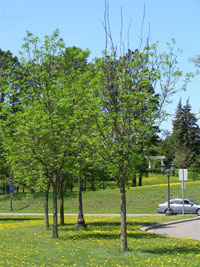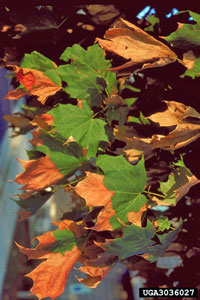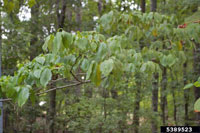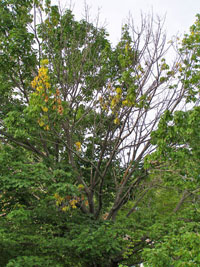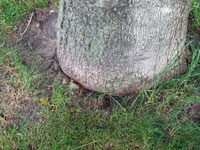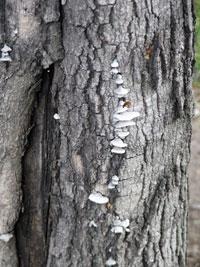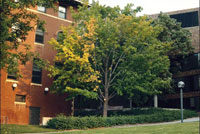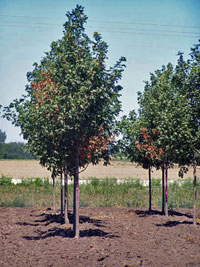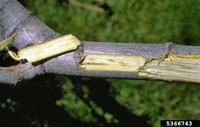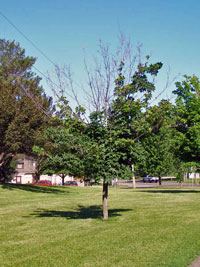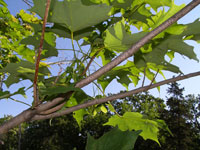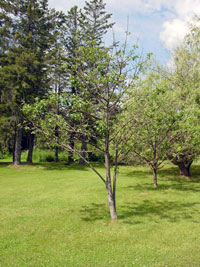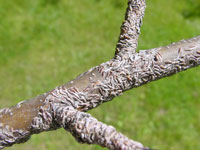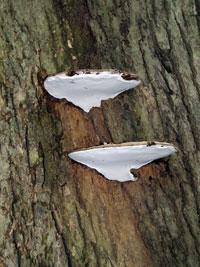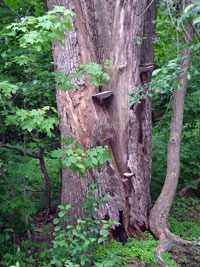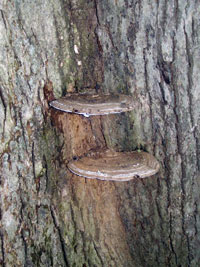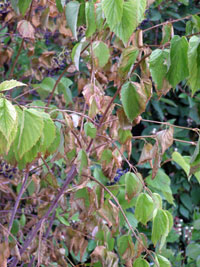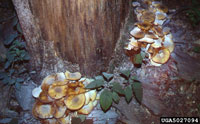Extension > Garden > Diagnose a problem > What's wrong with my plant? > Deciduous Trees > Maple > Scattered dead branches in canopy
Maple > Trunk/Branches > Scattered dead branches in canopy
1 of 9
Environmental stress
Drought, compact soils, flood damage, winter injury, other
- Dead branches in the canopy
- Leaves wilt and turn brown at the tips and the margins first, then completely brown
- Leaves appear drooped or wilted within canopy
- Many weak young shoots/sprouts at the base of the tree
- More information on caring for trees and shrubs
2 of 9
Stem girdling roots
- Affected trees are often have branch dieback, stunted growth, exhibit poor summer color, change color and lose their leaves early in the fall
- Affected trees commonly exhibit water-stress symptoms such as marginal leaf scorch, wilting, sudden leaf fall
- Affected trees commonly exhibit excessive and abnormal winter damage including frost cracks and dieback
- A root circling the trunk of the tree may be seen at the soil line
- Trunk may become sunken in or compressed where it contacts the root
- If girdling root is below ground, the trunk will lack the natural widening or flare at the soil line so will go straight into the earth like a telephone pole; trees often exhibit an abnormal lean
- More information on Stem girdling roots
3 of 9
Sapwood rot
Schizophyllum commune and Cerrena unicolor
- Dead branches within the canopy
- Groups or rows of small (<2 inches wide) semi-circle self fungi along killed branches or on the main trunk
- Schizophyllum shelf fungi are white and appear fuzzy on top
- Cerrena shelf fungi are white to greenish grey and have concentric rings on the surface
- Occurs on trees with an open wound or crack
- Wood below fungal shelves is yellowish to white, crumbly and decayed; bark around fungal shelves is killed and often falls off
4 of 9
Verticillium wilt
Verticillium dahliae
- Leaves turn brown from the edges and tips, wilt and die in severe infections
- Leaf symptoms are often seen on only one or a few random branches in the canopy
- Leaves are small and yellowed in chronic infections
- Dark brown to black streaks often can be seen in the sapwood if the bark is peeled back, appearing as rings or arcs in a cross cut
- Symptoms may develop over a single growing season, or over several years
- More information on Verticillium wilt
5 of 9
Branch cankers
Botryosphaeria obtusa, Valsa spp. and other fungi
- Random dead branches seen throughout canopy
- Leaves on random branches wilt, turn yellow then brown during the growing season
- Infected branches don’t leaf out in spring
- Cankers are brown to black sunken areas on branch that may have cracked bark and discolored sapwood
- Common on trees stressed by drought, winter injury, wounds, insect feeding or other factors
- More information on canker
6 of 9
Coral spot canker
Nectria cinnabarina
- Dead branches and twigs, often first observed in early spring
- Sunken dark brown area on branch that is often cracked or has a ridge at the edge
- Raised cushion-like bumps on affected branches, may be cream to orange or red, turn black with age
- Common on trees stressed by drought, recent transplant or other factors
- More information on canker
7 of 9
Oystershell scale
Lepidosaphes ulmi
- Twig and branch dieback can occur when branches are heavily infested
- Feeding can cause foliage to yellow
- Light to dark brown, elongated, 1/10 to 1/8 inch long, found feeding on branches
- Heavy infestations of “shells” can completely cover bark
- Damage occurs during summer
- More information on Oystershell Scale
8 of 9
Ganoderma root and butt rot
Ganoderma spp.
- Canopy appears thin with few leaves and multiple dead branches
- Leaves are smaller in size and turn yellow earlier than normal
- Fungal conks, a semicircle shelf fungi, can be found from the base of the tree up to 3 feet high on the trunk
- Conks are reddish brown and shiny on top, white and porous underneath, a rim of white may be visible on the edge of growing conks
- Infected wood at the base of the tree is white, soft, stringy or spongy
- Infected trees frequently break or fall over in storms
- More information on Ganoderma root and butt rot
9 of 9
Armillaria root rot
Armillaria spp.
- Infected trees have poor growth, dead branches in the upper canopy, undersized and/or yellow leaves
- Flat white sheets of fungal growth (mycelia fans) grow between the bark and sapwood at the base of infected trees
- Thick black, shoestring-like fungus can sometimes be seen under the bark, around roots and in the soil around the base of the tree
- Wood is decayed, white, soft and spongy, and this may extend from the base of the tree well up into the trunk.
- Trees frequently break or fall over in storms
- Clusters of honey-colored mushrooms may grow at the base of the tree in fall
- More information on Armillaria root rot



